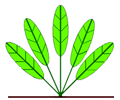


Indian Almond Leaves
Terminalia catappa
General information: Most trees in the wetdry tropics are deciduous, they shed leaves in the dry season to concerve moisture. When these dry leaves decompose in water, a thin film of bacteria forms on the leaf surface and that provides nutrition for small invertebrates such as snails and shrimp. It is the beginning of the food chain. The dead mangrove leaves in the estuary provide nutrition for a huge number of small critters thus the importance of the mangrove creeks as a nursery for many species of fish. Dry Indian Almond Leaves also release other compounds once they have fallen in the water. These compounds are beneficial to small creatures by making the water more friendly. Some of these compounds are tannins, quercetin (a type of flavonoid), kaempferol, punicalagins and other compounds that improve water quality.
Cultivation notes : These trees are from across the Indian Asian tropics and are quite common in the Australian tropics. Leaves are collected when they have fallen from the tree and dry.
Distribution : This tree is found from Africa to India through Asia, New Guinea and North Australia
Selling details : Dried leaves are sold in a 60 gram bag.
Reference: Wikipedia